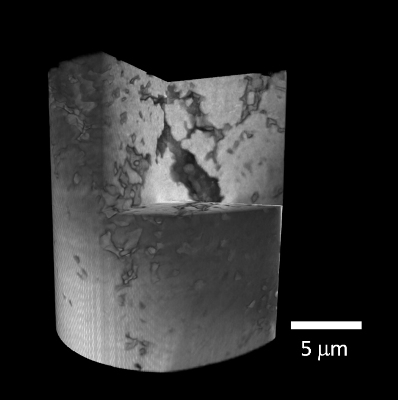A new full field transmission X-ray microscope (TXM), developed and installed at the National Synchrotron Light Source (NSLS) of Brookhaven National Laboratory (Brookhaven Lab), enables the Brookhaven Lab researchers to rapidly capture and integrate thousands of 2D images to create digital 3D constructs with high accuracy.
 This 3D reconstruction of a lithium-ion battery electrode, composed of 1,441 individual images captured and aligned by the TXM, reveals nano-scale structural details to help guide future energy research.
This 3D reconstruction of a lithium-ion battery electrode, composed of 1,441 individual images captured and aligned by the TXM, reveals nano-scale structural details to help guide future energy research.
The TXM’s capability to probe structures measuring 25 nm will advance several fields such as defense, biology, environmental sciences and energy research. This innovative device was developed by Xradia, a specialist in Xradia, using the fund provided by the American Recovery and Reinvestment Act. The X-ray source required for the TXM to capture the nanoscale images is provided by the NSLS. The results of the experiment performed on the TXM have been reported in the journal, Applied Physics Letters.
Jun Wang, a Brookhaven physicist who led the team that initially proposed the TXM, informed that the TXM allows the researchers to view a material’s internal 3D structure at the nanoscale. During the experiment, Wang’s group probed a 20-µm electrode of a lithium-ion battery using the TXM. The sample was placed on a platform equipped with three sensors, which measured nanoscale shifts in all directions while the battery rotated and the microscope captured images. These images were then calibrated with the help of a gold sphere and then recorded by the computer, which then precisely assembled the images to form the final 3D construct after automatically compensating for any shifts. The team captured 1,441 2D images of the electrode. The whole process took just four hours. The NSLS X-ray source played a major part in this study.
Besides enabling direct structural scrutiny, the TXM will also develop chemical and elemental perceptive of materials. Wang’s team is currently working on demonstrating this capability of the TXM. Although the TXM will focus on storage solutions and alternative energy fuels, the basic insights are useful to advanced electronics, catalysts and plant root structures.
This TXM’s capabilities can be harnessed further during the availability of the Brookhaven Lab’s NSLS-II, which is slated for operation in 2015. The NSLS-II’s X-ray brightness or higher beam flux will be 1,000 folds quicker than that of the NSLS.